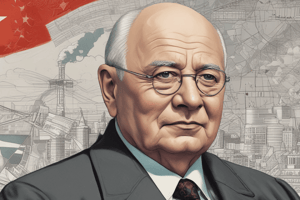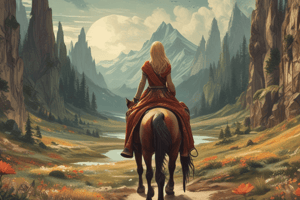Podcast
Questions and Answers
What was the Strategic Defense Initiative (SDI) also known as?
What was the Strategic Defense Initiative (SDI) also known as?
- Star Wars (correct)
- Space Shield Initiative
- Galactic Defense Initiative
- Cosmic Protection Program
What was Gorbachev's main concern about the Strategic Defense Initiative (SDI)?
What was Gorbachev's main concern about the Strategic Defense Initiative (SDI)?
- It would lead to the militarization of space
- It would give the United States an advantage in nuclear conflict (correct)
- It would threaten world stability
- It would weaken the Soviet economy
What was the outcome of the meeting in Reykjavik regarding arms reduction?
What was the outcome of the meeting in Reykjavik regarding arms reduction?
- The United States agreed to stop the SDI project
- Both sides agreed to completely eliminate nuclear weapons
- The Soviets agreed to reduce their nuclear arsenals
- No agreement was reached (correct)
What was the significance of the Washington Summit towards the end of 1987?
What was the significance of the Washington Summit towards the end of 1987?
What did Gorbachev announce at the United Nations a year after the Washington Summit?
What did Gorbachev announce at the United Nations a year after the Washington Summit?
What was the American perception of the Strategic Defense Initiative (SDI)?
What was the American perception of the Strategic Defense Initiative (SDI)?
What was Gorbachev's main goal in reducing nuclear weapons?
What was Gorbachev's main goal in reducing nuclear weapons?
What event signaled the end of the Cold War between the USA and the Soviet Union?
What event signaled the end of the Cold War between the USA and the Soviet Union?
What was the name of the movement that emerged from the strike at the Lenin Shipyard in Gdansk?
What was the name of the movement that emerged from the strike at the Lenin Shipyard in Gdansk?
Who was the leader of the Soviet Union during the meeting off the coast of Malta in 1989?
Who was the leader of the Soviet Union during the meeting off the coast of Malta in 1989?
What was the response of the communist government to the workers' protests in Poland in the 1970s?
What was the response of the communist government to the workers' protests in Poland in the 1970s?
Which leader tried to create a more open and democratic society in Czechoslovakia but was arrested and replaced by a Soviet-backed leader?
Which leader tried to create a more open and democratic society in Czechoslovakia but was arrested and replaced by a Soviet-backed leader?
What did Gorbachev announce during the news conference after his meeting with George Bush Senior off the coast of Malta?
What did Gorbachev announce during the news conference after his meeting with George Bush Senior off the coast of Malta?
What was the outcome of the introduction of Glastnost and Perestroika in the USSR?
What was the outcome of the introduction of Glastnost and Perestroika in the USSR?
What was the result of the sit-in at the Gdansk Shipyard in the 1980s?
What was the result of the sit-in at the Gdansk Shipyard in the 1980s?
What was the response of the USSR to the growth of Solidarity's membership?
What was the response of the USSR to the growth of Solidarity's membership?
What did Gorbachev advise the Polish government to do?
What did Gorbachev advise the Polish government to do?
What was the significance of Solidarity winning the elections?
What was the significance of Solidarity winning the elections?
What was the impact of Poland's success on other communist satellite states?
What was the impact of Poland's success on other communist satellite states?
What did the fall of the Berlin Wall symbolize?
What did the fall of the Berlin Wall symbolize?
What did the protest against increased food prices in Poland turn into?
What did the protest against increased food prices in Poland turn into?
What did the communist government try to do to address crises?
What did the communist government try to do to address crises?
What was the result of Solidarity's demands?
What was the result of Solidarity's demands?
Who aimed to reform communism from within to prevent its collapse?
Who aimed to reform communism from within to prevent its collapse?
What were the reforms implemented by Gorbachev to loosen the party's grip on the economy and allow people to question the past?
What were the reforms implemented by Gorbachev to loosen the party's grip on the economy and allow people to question the past?
Who was the last leader of the USSR?
Who was the last leader of the USSR?
Who criticized party members and sought to make his mark by sacking corrupt officials?
Who criticized party members and sought to make his mark by sacking corrupt officials?
What did Gorbachev propose to give the people a say in how the country was run?
What did Gorbachev propose to give the people a say in how the country was run?
What did Gorbachev and Reagan mark the beginning of in 1985?
What did Gorbachev and Reagan mark the beginning of in 1985?
What did the KGB enforce, leading to repression and fear among the Soviet people?
What did the KGB enforce, leading to repression and fear among the Soviet people?
Flashcards are hidden until you start studying
Study Notes
The Fall of the Soviet Union
- The USSR was a superpower formed after the 1917 Revolution led by Lenin, aiming to create a communist society based on Karl Marx's ideas.
- Joseph Stalin pushed through an industrial revolution to fulfill Lenin's promises, but by 1991, the Soviet people rejected communism and the USSR collapsed.
- The last leader of the USSR, Mikhail Gorbachev, aimed to reform communism from within to prevent its collapse.
- Gorbachev faced challenges from the entrenched nomenclature, a class of privileged Communist Party officials who controlled the economy and society.
- Gorbachev implemented glasnost (openness) and perestroika (restructuring) to loosen the party's grip on the economy and allow people to question the past.
- Boris Yeltsin, appointed by Gorbachev, criticized party members and sought to make his mark by sacking corrupt officials.
- Yeltsin's popularity with the people led to his sacking by the party hardliners, showing the resistance to Gorbachev's reforms.
- Gorbachev proposed a new Congress of people's deputies, directly elected by the people, to give them a say in how the country was run.
- Gorbachev sought a new relationship with the West, aiming to reduce military spending and halt the nuclear arms race.
- The Soviet Union and America faced each other in a nuclear arms race, which the USSR could no longer afford, leading to Gorbachev's attempts to build trust with Western leaders.
- Gorbachev and Reagan met in Geneva in 1985, marking the beginning of Gorbachev's efforts to forge a new relationship with the United States.
- The KGB, the Soviet secret police, enforced the Communist Party's control and silenced dissent, leading to repression and fear among the Soviet people.
Studying That Suits You
Use AI to generate personalized quizzes and flashcards to suit your learning preferences.




